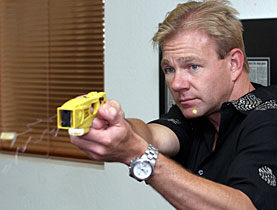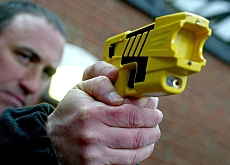Swiss discuss use of “torture” weapon

Despite United Nations concerns on Tasers, Switzerland's House of Representatives is pushing for federal police to be armed with the electroshock stun guns.
The UN Committee against Torture recently judged Tasers to be a potentially lethal form of torture and urged Portugual to reconsider arming its police with them.
“The use of these weapons causes acute pain, constituting a form of torture,” the committee said at the end of its 39th session in Geneva.
“In certain cases they can even cause death, as has been shown by reliable studies and recent real-life events,” it said.
At the weekend a 36-year-old Canadian died four days after police used a Taser on him. He became the third person to die in recent weeks in Canada after being shocked by the hand-held weapon.
The Committee against Torture made its comments in recommendations to Portugal, which has bought the newest Taser X26 stun gun for use by police.
Portugal “should consider giving up the use of the Taser X26” as its use could have a grave physical and mental impact on those targeted, which violates the UN’s Convention against Torture, the experts said.
Although Tasers were originally proposed as alternatives to lethal force, critics say they are now routinely used to gain compliance at times when the use of firearms would not be considered.
According to Amnesty International, more than 280 people have died in the United States after being struck by Tasers.
But although several court cases are outstanding against Arizona-based Taser International, more than 50 wrongful-death or injury cases have been dismissed or won by the company.
Swiss debate
In January 2006 human rights groups welcomed a Swiss government decision to ban the use of electroshock weapons including Tasers during forced deportations. But under Switzerland’s federal system cantonal police forces retain the right to use such weapons.
Parliament is currently discussing guidelines on using Tasers as part of a debate on the use of weapons. The resulting law would apply to federal officers and cantonal police officers working under a federal mandate.
At present only specialist units of the cantonal police in Bern, Basel Country, Basel City and St Gallen as well as the city police in Bern and Zurich may use Tasers.
At the beginning of October the House of Representatives came out in favour of federal police officers using electroshock weapons.
The Senate has yet to take a stance, but its commission is against Tasers. The government has also said it is against them.
Excessive force?
While Tasers are not technically considered lethal, some authorities and non-governmental organisations question both the degree of safety presented by the weapon and the ethical implications of using a weapon that some, including Amnesty International, allege is inhumane.
Too often, critics say, trigger-happy police use “last resort” Tasers well before the situation merits them.
In September Florida University student Andrew Meyer became a YouTube star when he yelled “Don’t Tase me, bro!” at a policeman before the officer did just that in response to Meyer’s heckling of Senator John Kerry.
Amnesty and other civil liberties organisations have argued that a moratorium should be placed on Taser use until research can determine a way for them to be safely used.
Earlier this month Justice Minister Christoph Blocher from the rightwing Swiss People’s Party claimed to have let himself be Tasered to experience the weapon’s effects for himself.
swissinfo with agencies
The trademark Taser is an acronym for “Thomas A. Swift’s Electric Rifle”. Arizona inventor Jack Cover designed it in 1969 and named it after the science fiction teenage inventor and adventurer Tom Swift.
The Taser uses a temporary high-voltage low-current electrical discharge to override the body’s muscle-triggering mechanisms.
Two barbed darts embed themselves into the skin and deliver a series of around 50,000-volt electrical pulses for up to five seconds. The maximum range of the darts is 10 metres.
Experts say a shock lasting half a second will cause intense pain and muscle contractions. Two to three seconds will often cause the subject to become dazed and drop to the ground. More than three seconds will usually completely disorient and drop someone for up to 15 minutes.

In compliance with the JTI standards
More: SWI swissinfo.ch certified by the Journalism Trust Initiative

You can find an overview of ongoing debates with our journalists here. Please join us!
If you want to start a conversation about a topic raised in this article or want to report factual errors, email us at english@swissinfo.ch.